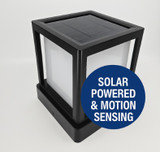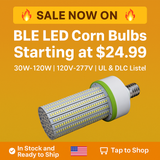What Is Induction Lighting And How Does It Work?
Induction lighting is a type of lighting technology that doesn't use electrodes or filaments. This type of lighting has been around for more than 100 years and has a life cycle of up to 100,000 hours.
It's for this reason that induction lighting is often used in industrial properties such as factory buildings and street lights for roadway lighting. Compared to the standard halogen bulb, induction lighting is significantly more energy-efficient and has been making its way to the U.S. as a green option for warehouse lighting fixtures.
How Does An Induction Lamp Work?
An induction lamp works by creating light much in the same way that a fluorescent bulb does. Induction lamps use an electromagnetic field to activate mercury particles inside the glass.
The mercury particles are mixed with an inert gas such as krypton or argon. When these particles are excited, they create a UV light. Inside the induction bulb, a phosphor is used to filter the light inside a visible light.
What Are The Pros And Cons?
Induction lighting has quite a number of advantages, which is what makes it such a popular energy-efficient lighting choice in Europe and other parts of the world. Induction lights don't run on electrodes, which can fail in traditional types of fluorescent lamps.
Additionally, unlike fluorescent bulbs, induction bulbs come in a sealed tube. Therefore, there isn't as great a risk of the bulb breaking and releasing mercury into the air.
Induction lights are also incredibly energy efficient. In fact, they can produce as many as 80 lumens per watt and with no flickering. And unlike other types of bulbs, the induction bulb can provide light for both large and small areas depending on the type of bulb you use.
However, it should be noted that induction lighting does have a share of disadvantages. For instance, induction bulbs are often bulky and, because of their inductive qualities, they can cause problematic interference with radio waves. It's for these reasons that induction lighting is often limited to the use of warehouses and roadways.
Induction lighting is an energy-efficient alternative to halogen bulbs and other types of lighting for industrial and commercial properties. For more information on induction lighting and LED warehouse lighting fixtures, contact Induction Lighting Fixtures today.
Recent Posts
-
How Long Will Solar Powered Lighting Operate in the Rain?
How Solar Light Fixtures Can Run for 10 Rainy Days If you’ve ever wondered how a Commercial solar li …Jul 30th 2025 -
Spotlight - The IL-SPG54 Smart Solar Walkway Light: Where Performance Meets Simplicity
Introducing the IL-SPG54 Smart Solar Walkway Light: Where Performance Meets Simplicity When it comes …Jun 16th 2025 -
Corn Bulb Sale - While supplies last!
⚡ Limited Time Sale – BLE Series Corn Lamps Starting at $24.99! Stock up now while supplies last – p …Jun 11th 2025






